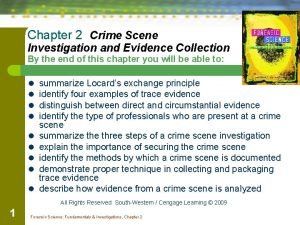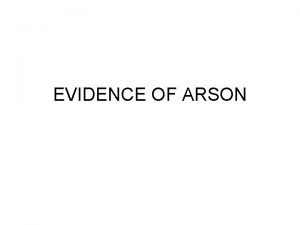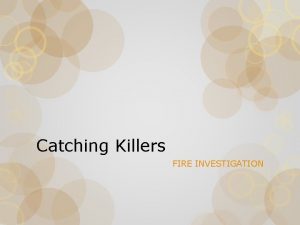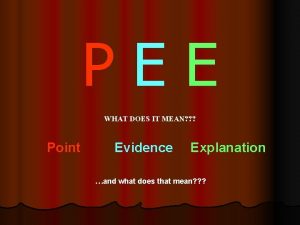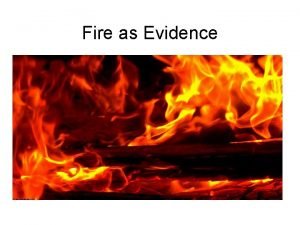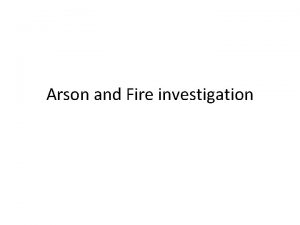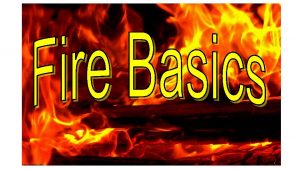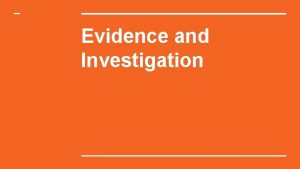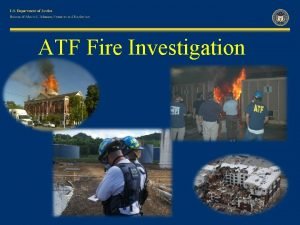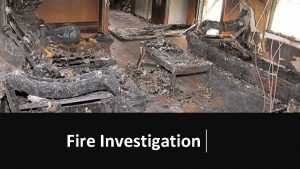Fire as Evidence Fire Investigation Terms Point of






















- Slides: 22

Fire as Evidence

Fire Investigation Terms • Point of Origin – The location where the fire started. • Burn patterns –Noticeable patterns created by the fire as it burns. • Accelerants – Substances, such as gasoline, paint thinner, and alcohol, that accelerate the burning process. • Arson –the criminal act of starting a fire

Fire Clues • Char Patterns – Created by very hot fires that burn very quickly and move fast along its path, so that there can be sharp lines between what is burned and what isn't. – A char pattern on a door would help determine which side of the door the fire was on. – A char pattern on the floor would help determine the use of an accelerant and its path. • V-Patterns - Fire burns up, in a V-shaped pattern, so a fire that starts at an outlet against a wall leaves a char pattern that points to the origin. – A very narrow V-shape might indicate a fire that was hotter than normal, such as one helped along by an accelerant. – A wide V-shape might indicate a fire that was slow burning. – A U-shape could indicate that there was a "pool of origin" rather than a point of origin, such as might be caused by, say, a puddle of gasoline.

• Heat Shadows - Occur when furniture shields part of a wall; can help determine the origin point. • Glass - Glass fragments, windows, and light bulbs can provide clues to a fire. – Light bulbs tend to melt toward the heat source, so the "direction of melt" can indicate the direction of the fire. – The shattered or cracked glass of the windows can provide indications as to how a fire burned. – A dark soot layer on the glass could indicate a slow, smoldering fire. – Clear glass with an abnormal pattern of cracking could imply a very hot fire, possibly due to an accelerant. • Chimney Effect - Since fire burns upwards, the superheated gases rise upward and form a fireball, straight up to burn a hole in the ceiling. • Color of smoke – Determine what type material was burning • Color of flames – Indicates at what temperature the fire was burning.

EXAMPLES OF BURN INDICATORS • • Alligatoring Depth of char Breaking of glass Collapsed furniture springs Spalling Distorted light bulbs Temperature determination 18 -8


LINE OF DEMARCATION IN A WOOD SECTION • Depth of char – is used for evaluating fire spread – is used to estimate the duration of a fire – the rate of charring of wood varies widely (Source: Factory Mutual Engineering Corporation, Norwood, Massachusetts. Reprinted with permission. ) 18 -9

Fire Investigation Basics • Work from the least damaged areas to the most heavily damaged areas. Determine the point of origin. • Document with notes, photographs, and videos. • Collect evidence (accelerant samples, fire items, and other crime scene evidence. ) • Interview witnesses • Determine the heat source(s). • Hypothesize the reasons for the fire.

Fire Classification • Natural-lightning, intense sunlight • Accidental-unintentional and explainable. Faulty wiring, malfunctioning, human error • Undetermined-cause is unknown • Deliberate-intentionally set (not all are arson)

COMMON MOTIVATIONS FOR ARSON • • • Arson-for-profit Revenge, spite, jealousy Vandalism/malicious mischief Racial/religious hostility Crime concealment/diversionary tactics Psychiatric afflictions – pyromaniac – schizophrenic firesetter – Vanity, hero fire 18 -15

The Fire Scene • Some telltale signs of arson include evidence of separate and unconnected fires, the use of “streamers” to spread the fire from one area to another, and evidence of severe burning found on the floor as opposed to the ceiling of a structure, due to a flammable liquid. • Normally, a fire has a tendency to move in an upward direction, and thus the probable origin will most likely be the lowest point showing the most intense characteristics of burning.

Collection of Evidence Accelerant remains can be detected by tracing the point of origin or canine use. Object containing accelerant must be packaged in air tight container.

Collection • At the suspect point of origin of a fire, ash and soot, along with porous materials which may contain excess accelerant, should be collected and stored in airtight containers, leaving an airspace to remove samples.

Collection • Traces of flammable liquid residues may be located with a vapor detector (sniffer). • It is important that a sampling of similar but uncontaminated control specimens be collected. • A search for ignitors such as matches, an electrical sparking device, or parts of a “Molotov cocktail” must also be conducted.






Arrow pattern of burning, showing fire travel.

Arrow pattern of burning, showing fire travel.

 Locard exchange principle
Locard exchange principle Fire and arson investigation ppt
Fire and arson investigation ppt Catching killers fire investigation
Catching killers fire investigation Polynomial degrees and terms
Polynomial degrees and terms Like terms in algebra
Like terms in algebra What is a primary source
What is a primary source Primary evidence vs secondary evidence
Primary evidence vs secondary evidence Primary evidence vs secondary evidence
Primary evidence vs secondary evidence Primary evidence vs secondary evidence
Primary evidence vs secondary evidence Primary evidence vs secondary evidence
Primary evidence vs secondary evidence How can class evidence have probative value
How can class evidence have probative value Class evidence vs individual evidence
Class evidence vs individual evidence Explain how class evidence can have probative value
Explain how class evidence can have probative value Class vs individual evidence
Class vs individual evidence The ecological fallacy
The ecological fallacy How to name planes
How to name planes Point, proof comment examples
Point, proof comment examples Peel paragraph examples
Peel paragraph examples Point evidence explanation
Point evidence explanation Reichstag fire who was the fire starter
Reichstag fire who was the fire starter Damper interface panel
Damper interface panel Fire hose reel signage standards
Fire hose reel signage standards A-e rwi
A-e rwi
